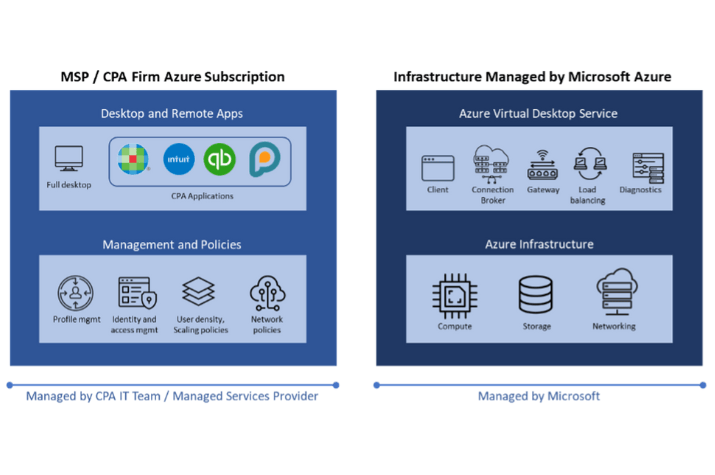As a Cloud Managed Services Provider (MSP) focused on the CPA profession, we work extensively with CPA firms to manage their IT infrastructure and deliver a virtual desktop solution that packages their key business applications (CCH Axcess or ProSystem fx Tax, CCH Engagement, Thomson Reuters CS Professional Suite, Checkpoint and Onvio, CaseWare, QuickBooks, Practice Engine, Lacerte) and employee collaboration platforms (Microsoft Teams, Slack, Zoom).
Virtual desktops were prevalent in the CPA community but have gained even more prominence across the pandemic with workforces going remote, making device mobility and security even more paramount. Azure Virtual Desktop, also known as AVD, is Microsoft’s cloud-based virtual desktop solution providing a remote desktop experience from anywhere. With Microsoft putting its muscle behind AVD, adoption in the CPA profession is on the rise. There are several reasons why AVD is increasingly appealing including:
- Optimized for Increasingly Distributed CPA Workforce: The pandemic has disrupted the CPA labor markets and ushered in a new hybrid paradigm. With the firm’s workforce now expecting to work from anywhere, delivering a consistent experience that fosters a high level of productivity becomes imperative. Employees expect seamless and undisrupted remote access to their IT workspace across a broad spectrum of internet connectivity scenarios. There are two key performance considerations in servicing this increasingly remote workforce – latency and speed. The end-user experience of opening, working in, and moving between applications throughout their workday quickly and efficiently is a must. Firms with extensive experience in running and managing AVD for the CPA vertical have done the heavy lifting of optimizing the configurations for legacy CPA applications like CCH Engagement, Pfx Tax, and QuickBooks. This includes intelligent placement of the supporting cloud infrastructure across the various Microsoft Azure global regions, use of network optimization tools, sizing of the compute resources, selection of the right storage tiers, etc.
- Enhanced Security for Offshore Outsourcing Models: In the search for talent and capacity, CPA firms are turning offshore. This introduces a new dimension of risk, making securing sensitive data even more paramount. AVD facilitates a thin-client model with the applications and data staying within the boundaries of the US, abstracted from the end-user terminal that is accessing the information. The solution enables additional safeguards and controls like multi-factor authentication (MFA), conditional access policies, screen capture protection, maximum inactive/disconnection time policies and screen locks, network access controls like geo-blocking, data encryption, end-point detection and response tools (EDR). Firms can more confidently engage with outsourcing resources, knowing that their client data is secured with state-of-the-art tools and processes in well-designed AVD solutions.
- Designed for an Overstretched Internal IT Team: Microsoft has abstracted quite a bit of the complexity of running a remote desktop solution, removing the need for what used to be a complex infrastructure comprising RD Gateways, connection brokers, load balancers, database servers, etc. All of this gets shifted into Microsoft’s cloud, delivered as a Platform as a Service (PaaS) offering within AVD, along with any ongoing maintenance aspects like patching, resiliency, availability, and security. However, operating an AVD solution still requires a level of expertise in Azure including configuration, optimization, and security that MSPs like Netgain bring to the table. In addition, MSPs can shift operational tasks such as monitoring and maintenance of the environment away from the Internal IT team. This creates capacity for the Internal IT teams to work on Firm projects such as automation and new solution selection/adoption initiatives that support the Firm’s strategic objectives.
